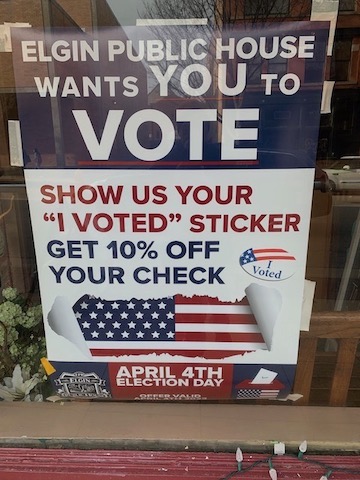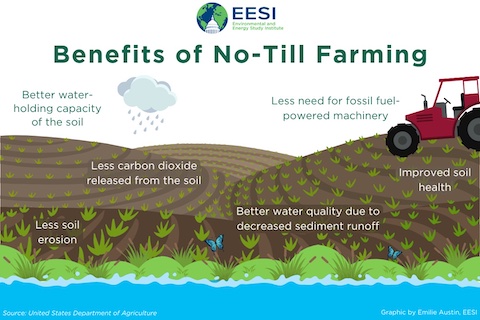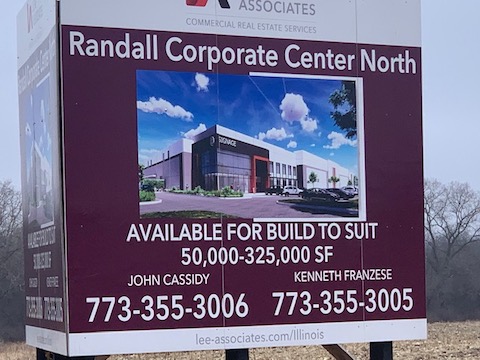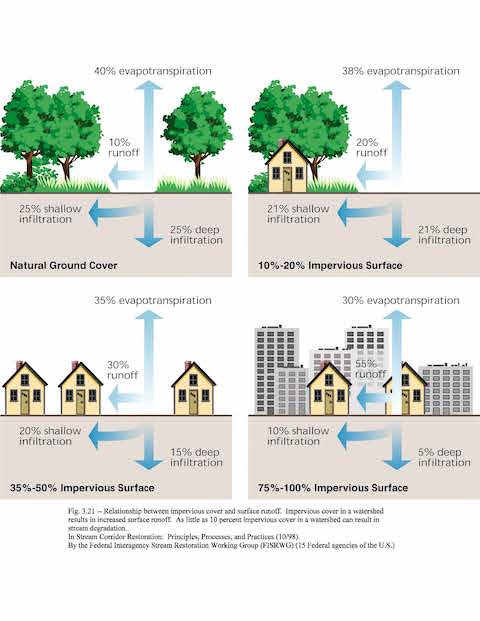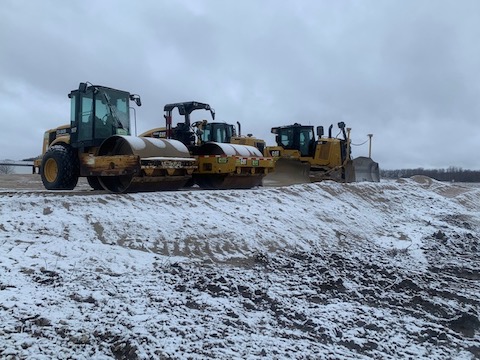If Not You, Then Who?
Spring is a period of transition. Cold one day and warm the next. But all the while new plant and animal growth is steadily emerging and soon to be blooming or birthing. Some of yesterday’s political candidates will be emerging as our new local decision and policy makers. Friends of the Fox River (FOTFR) was founded to give the Fox River a representative voice that was nonexistent in decision making. Each and every day, threats to the Fox River occur throughout the watershed and mostly on a local level. The locally-elected officials are a resource for us to use to care for our Fox River. Yesterday’s election results may impact you and the river!
Agricultural Influence
Sixty-four percent of the land in the watershed is used for agriculture. Once the natural landscape is converted from prairie, wetland, and woods to row crops, the streams and the river become vulnerable. Water quality threats from agriculture are in the form of soil erosion leading to sedimentation and habitat loss, excess nutrient contributions leading to ultimately lower dissolved oxygen levels, and to a smaller extent, other chemicals like neonicotinoid pesticides leading to toxic impacts upon stream biology.
Regenerative Agriculture Works
A challenge for protecting the Fox River Watershed from pollution exists because land zoned for agricultural use is usually in a private property holding and is very commonly leased property. Implementing protection measures must first make economic sense. Regenerative agricultural practices like cover crops and other no-till methods are slowly becoming more popular. They are demonstrating less soil erosion, increased soil fertility, higher crop yields, and consequently leading to environmental improvement and economic validity. This is very good news for improving protective practices for our river.
Development
When agricultural land gets further developed into residential projects, industrial parks, and the supporting infrastructure, bigger problems for our streams arise. Sprawling developments of massive amounts of rooftops, roads and parking lots decrease the soil’s ability to allow precipitation to naturally infiltrate. Stormwater runoff carries the chemical and litter contaminants on the ground into streams which impacts water quality. This added quantity of water (often 4 times the amount of twenty years ago) causes significant erosion damage, habitat loss from sedimentation and creates flooding conditions. Additionally, the increase of sewage into small tributaries and the ecological pressure is significant.
Local Zoning
Protecting our streams is a local concern because land use is controlled by local zoning commissions. For land to be converted from natural to agricultural usage requires approval of a municipal government. Further conversion from agriculture also requires a change in zoned land use to be assigned by a municipality. Many communities have developed land-use plans for projected future development. Sometimes these plans are followed and sometimes not. Here is where community members can make a difference. In Carpentersville, their plan called for light industry in a yet-to-be annexed area containing wetlands. A plan for a truck depot was presented which stimulated citizen action in opposition. Over 50 letters (including FOTFR) were submitted to the Army Corps of Engineers about the permit. Recently, the village rejected the proposal stating that light industrial wasn’t the best use for the property. This is maybe just a temporary protection of the wetlands, but it caused a reconsideration. It may also lead to a cooperative agreement with the neighboring Village of West Dundee and an initiative to purchase the property for public use. https://www.dailyherald.com/news/20230324/times-up-carpentersville-says-no-binnie-road-plans
Your Vote is Your Voice
From the beginning, Friends of the Fox River has been in the business of giving the watershed a voice in defense against destruction. The process of “building a watershed community of caretakers” is done through education. Providing awareness and literacy empowers the public sector to be a unified voice. In the case of this recent election day, your vote was your voice. The land-use decisions that are impacting our watershed are made on the local level. The county, township, city, village and town’s board, council, and trustees are the decision makers for what is allowed and are often encouraged financially to change land uses. The zoning & planning commissions are composed of these members and sometimes public sector volunteers. It is the public that can control decisions since we elect the decision makers.
Success Story
A great example of exercising public voice for watershed protection comes from Leonard Wardzala (a founding FOTFR Board member) from Lyons Township in Wisconsin. Disappointed with the local officials’ lack of interest in preservation, he and other conservation-minded locals used their rights to expand the town council to add two candidates. Just in case, they decided to run five candidates for all board positions. The April election rolled around and surprisingly they won all five seats! Now having control of planning and zoning, they adopted a land-use plan with a few key elements: no rezoning of agricultural land, and if there is going to be a subdivision that already has the zoning, 60% of the land would have to be put aside as open space in perpetuity. What followed was the formation of The Lyons Biodiversity Project as part of the Kettle Moraine Land Trust, which is conducting restoration projects. This is truly a model to inspire all of us. Check it out.
Riverfront Property
An example of a specialized land use of concern is riverfront property in downtown areas. For many years, our river towns had their backs to the river when it was the waste stream. Today, these towns are realizing the economic draw, and are reorienting to face and celebrate the river. However, some projects of multistory buildings are further excluding others from the river experience. River towns only have a small parcel of riverfront (about 2 miles apiece) which is irreplaceable and should be recognized as precious and be preserved. This is an issue where representatives need our opinions and support; they need to place preservation and public access above private exclusionary pursuits. This year, FOTFR joined a St. Charles group, Citizens for Responsible Development, in opposition to a proposed large-scale riverfront development. The result was the city council retracting their support of the proposal. This was another very significant victory and model. https://www.savestcriverfront.com/post/friends-of-the-fox-river-we-thank-you
Democracy
If we care about protecting the Fox River Watershed, we must use our democratic system. If we are silent, we are not part of the system and are at the mercy of those who are not silent. History has demonstrated that lobbying to influence representatives with money is effective; it’s referred to as a contribution. If we truly care about protecting and restoring our watershed, it is our responsibility to be active in the process. It begins with understanding the challenges. FOTFR’s role and the role of the organization’s Friends is to support and elect candidates that will carry our voice as decision makers. It doesn’t end there because we must educate and build relationships with our representatives so they can do their jobs in representing us. Local elections are often won by thin margins, so to get our preferred representatives in decision-making positions requires us to educate our neighbors, friends, and colleagues about them.
The Call to Action
Know the issues, share them with your representatives and social circles, support candidates that will represent your concerns, be a voice for the river with your words and your vote. Then continue to share your concerns with your representatives. FOTFR is seeking volunteers in each community to review planning commission meetings and minutes. Please contact us at info@fotfr.org if you can help. And there are many more ways to get involved. See our calendar and consider joining us at one of our many events this spring.
Listen and Learn
To learn about the issues of the Fox River, you can follow the Elgin Watchman’s 8-part series, The Fox River Story. Episode 1 Fox River Introduction offers a good background. Episode 2, Watershed Thinking dives into the various governmental agencies and organizations and their various responsibilities and jurisdictions. Use this link to listen and learn. https://www.elginwatchman.com/episodes
A partial list of the agencies and organizations that manage and protect the Fox River:
Who Protects the Fox River?
Federal level
US Environmental Protection Agency Region 5 – Human & Environmental Health
US Fish & Wildlife Service – Migratory Waterfowl, Hackmatack National Wildlife Refuge
US Army Corps of Engineers – The land that water is on, Fox River connectivity study
US Natural Resource Conservation Service – Land uses, St Charles office
US Geologic Survey – Data & report, Water Quantity, Flow rates
US Dept of Agriculture – Farm Bill soil conservation programs
State level
Illinois and Wisconsin Environmental Protection Agency – Water Quality
Illinois and Wisconsin Department of Natural Resources – Flora, Fauna, Land use, Hunting & Fishing permitting
Illinois Natural History Survey – Habitat
Illinois State Water Survey – Water data
Illinois River Watch – Citizen Science
Wisconsin Water Action Volunteers – Citizen Science
Regional level
Southeast Wisconsin Regional Planning Commission
Chicago Metropolitan Agency Planning
County Soil & Water Conservation Districts – Consultation
County Forest Preserve and Conservation Districts – Land preservation, recreation, education
Dundee Township Open Space District – Preserve, restoration, educate
Fox River Study Group – research and implementation plan
Municipalities (This is only a partial list)
Fox River Watershed Reclamation District
Fox Metro Water Reclamation District
Every municipality’s Sanitary District
Many Park Districts offer education and conduct ecological restoration
Organizations (This is only a partial list)
Izaak Walton League – Save Our Streams
Illinois Sierra Club/Valley of the Fox – Water Quality data
The Conservation Foundation – Saving Land Saving Rivers
Citizens for Conservation – preservation, restoration, education
Foxpath – Rails to Trails
Openlands – Greenways
Friends of the Fox River – Citizen Empowerment
Fox River Ecosystem Partnership
Paddling organizations – various groups, Trail keepers
32 Sub watersheds groups – information here: https://foxriverecosystem.org/fox/fox-subwatersheds-list

